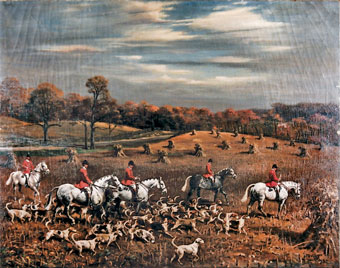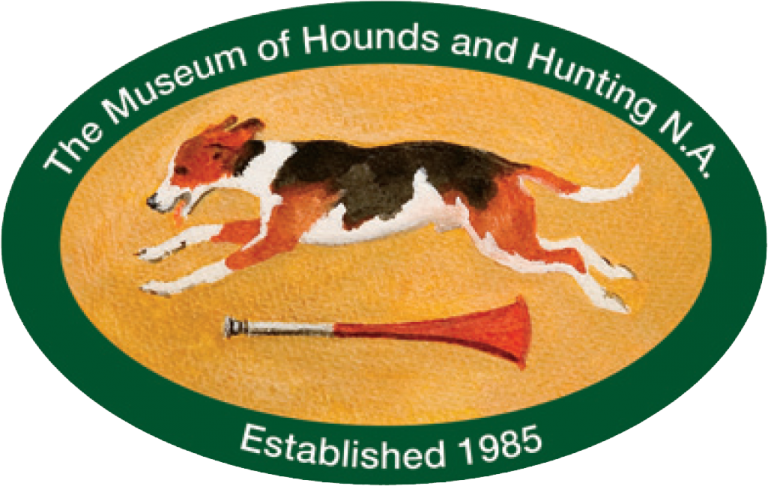Many hunting-related objects look and feel better with time and use. Paintings aren’t one of them. A century-old painting – faded, dull, cracked, and damaged – is diminished by the eroding influences of time, temperature, light, and pressure. Moreover, restoring a painting to its original appearance requires much more than a bit of cleaning or touchup. This highly specialized work calls for a package of skills only a few talented, well-trained conservators possess.
A conservator must combine the skills of an art historian, chemist, and material scientist with his own artistic ability. Fortunately, Alexander Katlan, who returned the John Ward Dunsmore paintings of George Washington in foxhunting scenes to their original appearance, possesses this package of skills.
“The process takes so much time,” Katlan says, “because one must understand both the chemical and mechanical structure of the painting, why it’s deteriorating.”
The work starts with a detailed report that identifies the painting’s structural problems and maps out a plan of action. Not only is the mission to restore the painting to its original condition but to keep it that way over the long term.
As Alexander Katlan explains it, “conservation is a newer term. Restoration has been done for centuries, back to the Renaissance. Conservation includes restoration but the broader objective is to stabilize the painting to delay the deterioration process.”
A variety of factors can cause a painting to degrade. One of the most pervasive causes is the layer of varnish applied over the finished work. When originally applied, the thin layer of varnish, traditionally a natural resin, leaves a transparent but glossy finish. Over time, though, the varnish darkens. The conservator’s chemical knowledge comes into play as he or she must determine the precise makeup of the varnish and then use the appropriate solvent to remove only the varnish while preserving the original pigment.
Environmental factors can also damage a painting’s appearance, particularly works that predate electric light and central heating systems. Conservators are often faced with the degrading influences of smoke from candles and open fireplaces, wide temperature swings, ambient air that is either too humid or too dry, and exposure to direct sunlight.
The conservator may have to deal with the previous meddling of would-be restorers, which can add substantial work to the assignment. This is especially true of older paintings on which restoration attempts were made using materials only slightly better, if indeed better at all, than the original materials. Today’s conservators strive to use “reversible” materials; that is, substances that can be easily removed if the painting comes under the care of another conservator at some point in the future. That is a most thoughtful gesture, considering the person applying the reversible substances may have long gone to his reward by the time the painting’s next visit to the conservation studio comes due.
Given the ultimate objective to return the painting to its original appearance, the conservator must be highly knowledgeable of the materials used when the piece was first created as well as the unique style and material preferences of the individual artist. This is one of the reasons Alexander Katlan was chosen to work on the John Ward Dunsmore paintings. Mr. Katlan has been published in the Journal of the American Institute for Conservation and is the author of three books, one of which focuses on the materials used by 19th century artists. This equipped him to care for the collection with a special sensitivity for how Mr. Dunsmore would have created the works, most of which were done in the late 19th and early 20th centuries.
The final touch rests in the hands of a professional who is as much artist as art conservator. The objective is for the conservator’s hand to remain invisible so that only the original artist’s talent shows through. Unless the conservator possesses a level of skill on par with the original painter, the result may be an obvious touchup job.
Margaret Bardwell, who recently completed the conservation of The Meadow Brook Grays by Franklin Voss (American, 1880-1953), not only possesses this extensive skills set but is also a former foxhunter. She recalls hunting with the Arapahoe Hunt (CO), riding to the sport provided by renowned Huntsman and Master Dr. Marvin Beeman. When Mrs. Bardwell started riding as child, many ladies still hunted sidesaddle. She and her husband moved from Colorado to Potomac, Maryland, and now live in Fairfax County, Virginia.
The Voss painting she recently worked on for the Museum depicts five scarlet-coated gentlemen, each on a gray horse, moving with hounds across an autumn Long Island, New York, landscape in Meadow Brook’s country. The work was a gift to the Museum from Mrs. JHA Charles Becker of Aiken, SC. Franklin Voss is widely regarded as one of the premier American sporting artists. Born into a prominent New York family, he was himself an avid sportsman who rode in steeplechase races in his youth and hunted with many leading packs of his day in the US and UK.
Both his position and sporting pursuits gave Voss access to the upper echelons of the foxhunting community. Endowed with connections, a sportsman’s enthusiasm, and considerable talent, he fulfilled more than 500 commissions during his prolific career. His works include ladies and gentlemen mounted on exquisite hunters, legendary racehorses such as Man o’ War and Citation, graciously appointed barns, hunting field scenes, and more. Every piece was painted from life as he saw it; Voss never relied on photographs.
Mrs. Bardwell found that some previous work had been done on The Meadow Brook Grays but it was not extensive and had been performed correctly, using reversible materials. She found some fading had occurred, particularly to the autumn-colored trees at the painting’s center. A new coat of varnish (reversible, of course) was applied to assure the newly conserved work will remain vibrant for many years to come.
“The key is to know what not to do,” she said, noting that doing too much or using the wrong materials can result in damage to a valuable piece of artwork.
One factor that can influence a painting’s integrity but which may be overlooked is how well the painting was stretched. Mrs. Bardwell noted that a good stretcher was used on this piece and that contributed to its preservation over the more than 70 years that have passed since Franklin Voss applied the final brushstroke.
Horses, hounds, and hunting have long been favored subjects of the artist’s brush. Indeed, the earliest known artistic depictions were scenes of the hunt. Compared to cave wall drawings, the works of sporting and historical artists such as Munnings, Herring, Voss, or Dunsmore are relatively recent; but not so recent as to have been spared the degrading effects of time and environmental pressure.
The Museum of Hounds & Hunting North America is pleased to have been entrusted with several notable works of sporting art. And we’re fortunate to have talented conservators such as Alexander Katlan and Margaret Bardwell who can help us present these valuable works in their vibrant original condition for all to enjoy.




